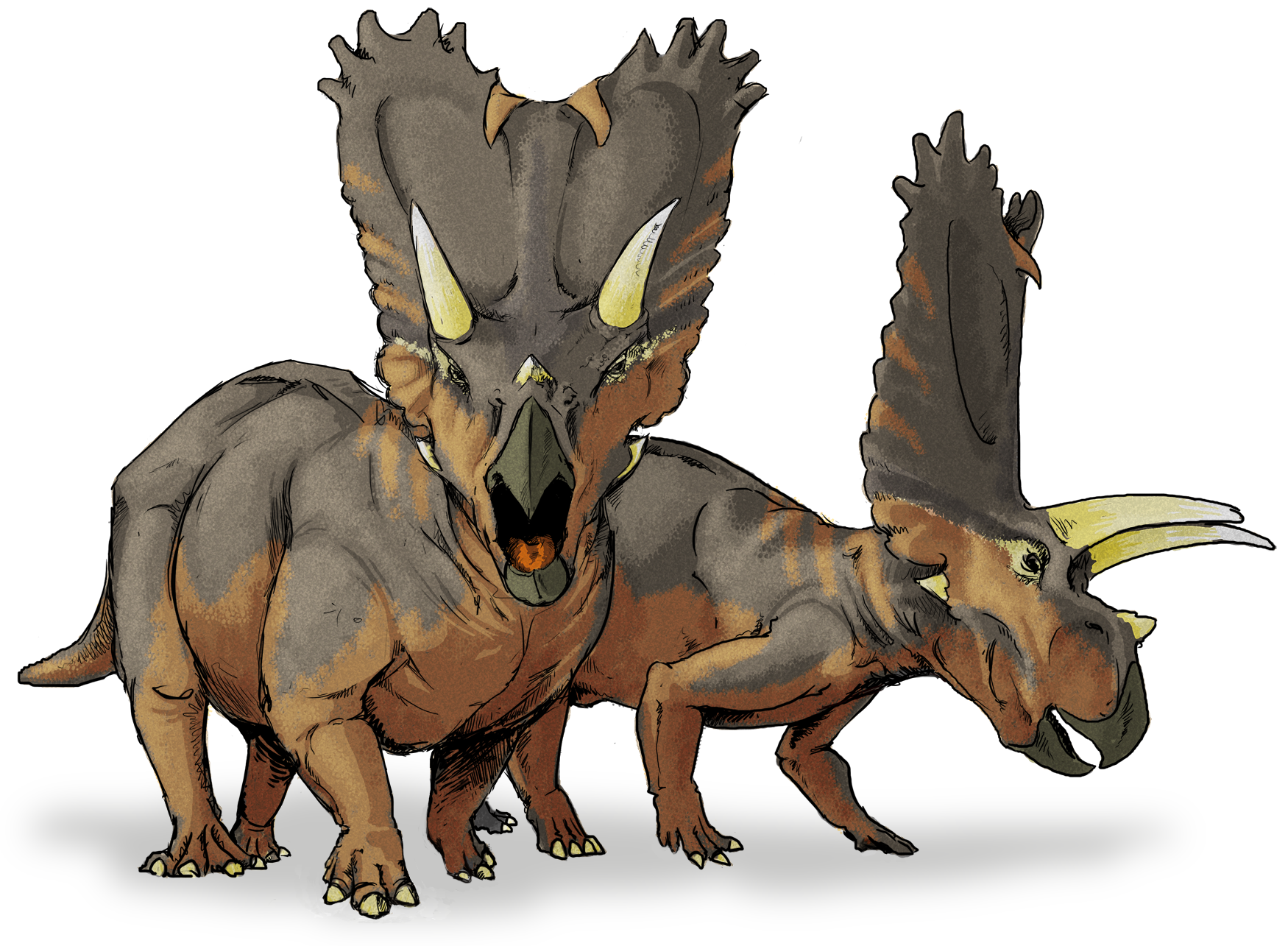We reach more than 65,000 registered users in Dec!! Register Now

New dinosaurs species with "winged crest"
- June 29, 2014
- 1052 Views
- 0 Likes
- 0 Comment
Sci≠en≠tists have named a new spe≠cies of horned di≠no≠saur based on fos≠sils col≠lect≠ed from Mon≠tana in the Un≠ited States and Al≠ber≠ta, Can≠a≠da. Mer≠curicer≠atops (mer-cure-E-sare-ah-tops) gem≠i≠ni was about six me≠ters (20 feet) long and weighed more than two tons, sci≠en≠tists say. It lived about 77 mil≠lion years ago dur≠ing the Late Cre≠ta≠ceous ...
Sci≠en¬≠tists have named a new spe¬≠cies of horned di¬≠no¬≠saur based on fos¬≠sils col¬≠lect¬≠ed from Mon¬≠tana in the Un¬≠ited States and Al¬≠ber¬≠ta, Can¬≠a¬≠da.
Mer­curicer­atops (mer-cure-E-sare-ah-tops) gem­i­ni was about six me­ters (20 feet) long and weighed more than two tons, sci­en­tists say. It lived about 77 mil­lion years ago dur­ing the Late Cre­ta­ceous Pe­ri­od. Re­search de­scrib­ing the new spe­cies is pub­lished on­line in the jour­nal Natur­wis­sen­schaf­ten.
Mer¬≠cur¬≠i¬≠cer¬≠atops¬†(Mer¬≠curi + cer¬≠atops) means ‚ÄúMer¬≠cury horned-face,‚ÄĚ re¬≠fer¬≠ring to wing-like or¬≠na¬≠menta¬≠t¬≠ion on its head that re¬≠sem¬≠bles the wings on the hel¬≠met of the Ro¬≠man god, Mer¬≠cu¬≠ry. The name ‚Äúgem¬≠i¬≠ni‚ÄĚ refers to the al¬≠most iden¬≠ti¬≠cal twin spec¬≠i¬≠mens found in north cen¬≠tral Mon¬≠tana and the UN¬≠ESCO World Her¬≠it¬≠age Site, Di¬≠no¬≠saur Pro¬≠vin¬≠cial Park, in Al¬≠ber¬≠ta, Can¬≠a¬≠da.
A plant-eater, Mer­cur­i­cer­atops had a parrot-like beak and probably two long brow horns above its eyes, ac­cord­ing to the in­ves­ti­ga­tors.
‚ÄúMer¬≠cur¬≠i¬≠cer¬≠atops¬†took a un¬≠ique ev¬≠o¬≠lu¬≠tion¬≠ary path that shaped the large frill on the back of its skull in¬≠to pro¬≠trud¬≠ing wings like the dec¬≠o¬≠ra¬≠tive fins on clas¬≠sic 1950s cars. It de¬≠fin¬≠i¬≠tively would have stood out from the herd,‚ÄĚ said study lead au¬≠thor Mi¬≠chael Ryan, cu¬≠ra¬≠tor of ver¬≠te¬≠brate pa¬≠le¬≠on¬≠tol¬≠ogy at The Cleve¬≠land Mu¬≠se¬≠um of Nat¬≠u¬≠ral His¬≠to¬≠ry.
‚ÄúHorned di¬≠no¬≠saurs in North Amer¬≠i¬≠ca used their elab¬≠o¬≠rate skull or¬≠na¬≠menta¬≠t¬≠ion to iden¬≠ti¬≠fy each oth¬≠er and to at¬≠tract mates-not just for pro¬≠tec¬≠tion from preda¬≠tors. The wing-like pro¬≠tru¬≠sions on the sides of its frill may have of¬≠fered male¬†Mer¬≠cur¬≠i¬≠cer¬≠atops¬†a com¬≠pet¬≠i¬≠tive ad¬≠van¬≠tage in at¬≠tracting mates.‚ÄĚ
‚ÄúThe butterfly-shaped frill, or neck shield, of¬†Mer¬≠cur¬≠i¬≠cer¬≠atops¬†is un¬≠like an¬≠y¬≠thing we have seen be¬≠fore,‚ÄĚ said study co-au¬≠thor Da¬≠vid Ev¬≠ans, cu¬≠ra¬≠tor of ver¬≠te¬≠brate pa¬≠le¬≠on¬≠tol¬≠ogy at the Roy¬≠al On¬≠tar¬≠i¬≠o Mu¬≠se¬≠um. ‚ÄúMer¬≠curicer¬≠atops shows that ev¬≠o¬≠lu¬≠tion gave rise to much great¬≠er varia¬≠t¬≠ion in horned di¬≠no¬≠saur head¬≠gear than we had pre¬≠vi¬≠ously sus¬≠pect¬≠ed.‚ÄĚ
The an¬≠i¬≠mal, clas¬≠si¬≠fied as part of a line¬≠age of horned di¬≠no¬≠saurs known as cer¬≠atopsians, is de¬≠scribed based on skull frag¬≠ments from two in¬≠di¬≠vid¬≠u¬≠als col¬≠lect¬≠ed from the Ju¬≠dith Riv¬≠er Forma¬≠t¬≠ion of Mon¬≠tana and the Di¬≠no¬≠saur Park Forma¬≠t¬≠ion of Al¬≠ber¬≠ta. The Mon¬≠tana spec¬≠i¬≠men was orig¬≠i¬≠nally col¬≠lect¬≠ed on pri¬≠vate land and ac¬≠quired by the Roy¬≠al On¬≠tar¬≠i¬≠o Mu¬≠se¬≠um. The Al¬≠ber¬≠ta spec¬≠i¬≠men was col¬≠lect¬≠ed by Su¬≠san Owen-Kagen, a pre¬≠par¬≠a¬≠tor in Phil¬≠ip Cur¬≠rie's lab at the Uni¬≠vers¬≠ity of Al¬≠ber¬≠ta. ‚ÄúSu¬≠san showed me her spec¬≠i¬≠men dur¬≠ing one of my trips to Al¬≠ber¬≠ta,‚ÄĚ said Ryan. ‚ÄúI in¬≠stantly rec¬≠og¬≠nized it as be¬≠ing from the same type of di¬≠no¬≠saur that the Roy¬≠al On¬≠tar¬≠i¬≠o Mu¬≠se¬≠um had from Mon¬≠tana.‚ÄĚ
 Source : world-science.net
Source : world-science.net 









